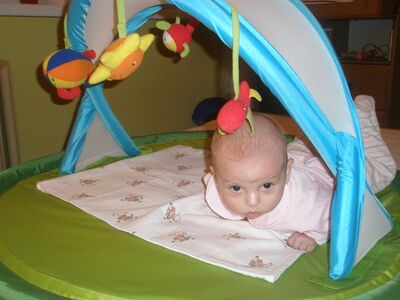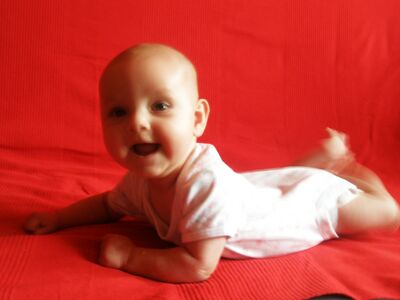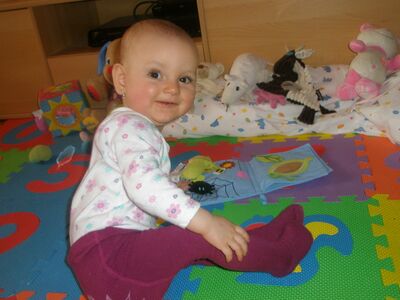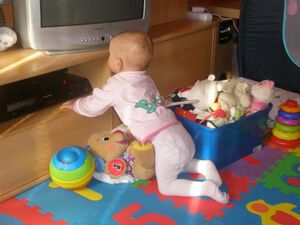Neuromotor development of the child
Neuromotor development of the child until achieving vertical standing[edit | edit source]
In newborn period, the posture and anatomy of individual joints and bones are quite immature - spine without lordotic curves, barrel-shaped chest, some angles between bones are not formed, the heel is high. The CNS matures and thus also the posture, and targeted and precisely defined movement behavior appears. The postural function of the muscles has a formative effect on the morphological development of the spine, hip joints, etc. The most obvious is the connection of the biomechanical principle with the neurophysiological principle. We can demonstrate this connection in disorders of the CNS, where due to the imbalance of muscle activity acting on the growth fissures, not only a disorder of postural functions occurs, but also anatomical disorders with biochemical consequences for the joint. The main means of determining central coordination disorder is the assessment of postural development. We assess postural activity, reactivity and primitive reflexology. When evaluating postural activity, we focus on the evaluation of erecting and antigravity functions (support, body posture), targeted phasic momentum (grip, method of locomotion). The development of postural activity is precisely kinesiologically defined. Knowledge of postural activity in individual periods allows us to assess the relationship between the motor state of the disabled child and the degree of physiological development.
First Trimenon[edit | edit source]
Neonatal stage[edit | edit source]
In the prone position, the center of gravity is located in the area of the sternum and navel. There is no base of support. The child insists on half in the range from the face through the chest to the navel area. The upper and lower limbs are flexed and are not capable of supporting function. The same posture also appears in the supine position. The child does not have optical fixation, but should be able to make short-term eye contact. The head is turned to one side - the so-called predilection posture. Such holding is physiological until the 6th week, it must not be fixed. In the supine position, the child must be able to turn his head to the other side. We find out by covering the view with our palms. The child not only changes the position of the head, but the whole body. We observe the reclining posture of the cervical spine.
The specific kinesiology content of the hold[edit | edit source]
- hand – finger flexion
- ulnar duction
- wrist flexion
- thumb closed in palm
- elbow – flexion, pronation
- shoulder – protraction, internal rotation
- blade - elevation
- spine - kyphosis
- pelvis – anteversion
- hip – flexion, abduction, external rotation
- knees – flexion
- foot – plantar flexion
The child does not have balance functions available. There is no ability to co-activate – synchronous activity between muscles with antagonistic function. There are some primitive reflexes - extension, suprapubic, heel, buckling reaction of the lower limbs, walking automatism, puppet eye phenomenon.
Week 4-6[edit | edit source]
Optical fixation appears. The child begins to raise his head against gravity, his forearm rests on the mat. Support begins to transfer caudally to the symphysis and pelvic anteflexion loosens. The supporting function of the lower limbs appears so that the chest can rise from the mat. This results in a global change in body posture. In the position on the back, the child is able to raise the legs above the mat, the predilection position of the head disappears and the position of the swordsman appears. The hand is open, the thumb is no longer closed in the palm.
Distinctive features[edit | edit source]
- primitive reflexes disappear
- coactivation appears
- equilibrium mechanisms start
- postural activity of phasic muscles appears
Second Trimenon[edit | edit source]
In the prone position, the elbow-elbow-symphysis forms the support base of the first support. In the supine position, the weight of the child is distributed between the linea nuchae, the level of the lower angles of the shoulder blades and the outer part of the gluteal muscles.
Thanks to the co-activation of antagonistic muscle groups, the extension of the axial organ is maintained. Autochthonous back muscles work together with the flexors of the front of the neck and intra-abdominal pressure. It is created by the co-activation of the diaphragm and the muscles of the pelvic floor and the muscles of the abdominal wall. The postural function of the diaphragm is very essential for the correct development of the spine during the entire subsequent postural ontogeny. The balanced activity of the antagonistic muscles enables a balanced position of the spine and joints, which are thus functionally centered and gently loaded. In affected children, uneven muscle activity causes joint decentration.
In the 2nd trimester, the child develops stereognosia, on the entire back (therefore the Galant's reflex must disappear) and in the hypothenar area (the grip reflex disappears upon contact with the hypothenar). If we offer the child an object from the middle plane, he will demonstrate a so-called generalized grasp: he is not yet able to physically grasp the object, but he reacts to it with his whole body - he opens the mesentery and closes his fingers. He reaches his genital area and his legs are coordinated enough to touch each other with their toes.
Half of the 2nd trimenon[edit | edit source]
The child is able to grasp an object in a prone position. Support is provided by the elbow, the spina iliaca anterior of one side and the epicondylus medialis femoris sides opposite. Stereognosis in the hand region is completed along with radial closure of the hand.
In the supine position, the support moves to the Th-L junction, which is therefore stabilized by the relevant muscles. The child is able to lift the pelvis, the coordination of the legs improves and can grasp an object given from the middle plane
The child can stretch the chest asymmetrically and thus transfer the weight to one shoulder, thus preparing for turning later.
5th and 6th month[edit | edit source]
During this period, the development of turning from the back to the stomach is completed, thanks to the fact that the child begins to grasp objects even through the middle plane. At the same time, he begins to roll onto his side and in the sixth month he can turn from his back to his stomach. The grasping upper limb is on the same side as the reaching lower limb, i.e. ipsilaterally.
When gripping on the stomach, the elbow and the medial epicondyle of the knee are typically supported in this period on the opposite side (i.e. on the side of the gripping upper limb). In the prone position (without holding), the child rests on the root of the hand and the front of the thighs.
At the end of the sixth month, the child achieves hand-foot coordination and begins to touch his feet with the pelvis raised. The coordination of the legs is also improved, which can now touch each other with the flats.
From a biomechanical point of view, the forward limbs behave as open kinematic chains, the supporting limbs as closed chains. The oblique abdominal chains also enter the function, which will allow the rotation of the trunk together with the stepping of the lower limb.
Third Trimenon[edit | edit source]
During the third trimester, the following crucial moments occur in a child:
- climbing on all fours
- oblique seat
- upright knee
These moments are essential for achieving vertical standing and subsequently for the initiation of bipedal locomotion. A pincer grasp with thumb opposition appears on the upper limbs. In general, grasping occurs more and more frequently in the child during this period due to postural fixation.
Straightening and stepping[edit | edit source]
The erecting (supporting) and reaching limbs are placed contralaterally - if the left upper limb is reaching and the right is supporting, the left lower limb is supporting and the right is reaching. The pelvis is strengthened by back muscles and intra-abdominal pressure. A prerequisite for biomechanically optimal standing is a balanced stabilization of the scapula. Climbing on all fours develops from this model during the ninth month.
Position on all fours[edit | edit source]
The child also gets into this position through an inclined seat. In oblique sitting, the support is provided by the medial gluteal muscle and the ipsilateral elbow, this support matures into support for the palm during the third trimester. The child also uses the slanted seat for grasping.
Upright sitting[edit | edit source]
From an inclined sitting, the child also gets to sitting upright, which is a sign of preparation for verticalization to standing. At the end of the 8th month, an upright knee appears with contralateral limb support.
Fourth Trimenon[edit | edit source]
Verticalization to standing takes place through the models below.
Verticalization from a position on all fours[edit | edit source]
One limb is placed on all fours and gradually comes into a flexed position with support on the foot. The child transitions into support on the palms and the front of both feet, which leads to a deep squat and subsequent standing.
Verticalization from an upright kneeling position[edit | edit source]
The child steps with one limb (the so-called erecting limb) and through the support of the contralateral upper limb, the child gets to a standing position.
From standing, walking in the frontal plane (along furniture with support of the upper limbs) first develops, followed by independent bipedal locomotion between the 12th and 14th months of life.
Links[edit | edit source]
Related Articles[edit | edit source]
- Child's psychomotor development • Child's age distribution and characteristics of individual periods (child's psychosocial development) • Psychological development according to E.H. Erikson • Child's growth and development
External links[edit | edit source]
- MUDr. Kučerovská: Developmental examination of a newborn
- MUDr. Cíbochová: Psychomotor development of a child in the first year of life
References[edit | edit source]
- BANASZEK, G. Vojta's method as the early neurodevelopmental diagnosis and therapy concept. Przegl Lek. 2010, 1, pp. 67-76. ISSN 20509579.
- VOJTA, V. Early diagnosis and therapy of cerebral motor disorders in childhood: Postural reflexes in developmental kinesiology, Normal developmental stages. From Orthop Ihre Grenzgeb.. 1972, 4, pp. 450-457.
- KOLÁŘ, P. Rehabilitace v klinické praxi. 1. edition. Praha : Galén, 2010. 713 pp. ISBN 978-80-7262-657-1.
- ORTH, Heidi. Dítě ve Vojtově terapii : příručka pro praxi. 1. edition. České Budějovice : Kopp, 2009. 216 pp. ISBN 978-80-7232-378-4.




